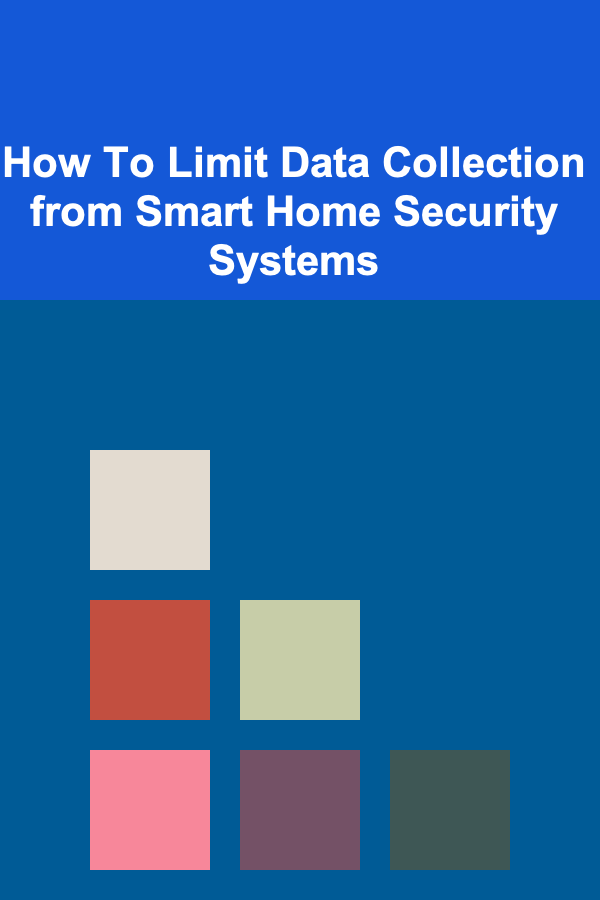
How To Limit Data Collection from Smart Home Security Systems
ebook include PDF & Audio bundle (Micro Guide)
$12.99$10.99
Limited Time Offer! Order within the next:

In today's world, smart home security systems are becoming a central part of modern living. They offer convenience, enhanced protection, and peace of mind by enabling homeowners to monitor their properties remotely, receive alerts, and track various events in real-time. However, as these systems gather an increasing amount of personal data to operate effectively, they also raise concerns about privacy and the security of that data. It's important to understand how to limit data collection from these devices to safeguard personal information without compromising the benefits these systems provide.
This article will explore the key concepts of data collection in smart home security systems, how data is gathered, and practical steps that users can take to limit this data collection. By understanding the technology behind these devices and employing strategies to manage data, users can better control their privacy while maintaining a secure home.
Understanding Data Collection in Smart Home Security Systems
Smart home security systems typically consist of a network of devices, such as cameras, motion sensors, doorbell cameras, alarm systems, and other IoT (Internet of Things) devices. These devices collect data continuously to monitor and respond to activities within the home and its surroundings. The data gathered is used for a range of purposes, such as:
- Real-time alerts: Notifying homeowners when suspicious activities are detected.
- Monitoring activity: Providing video footage and event logs to help homeowners review incidents.
- User preferences: Tailoring system settings to the specific needs and habits of the homeowner, such as automated lighting or temperature control based on occupancy.
While these devices provide convenience and safety, they often collect highly sensitive personal data, such as video footage, audio recordings, location data, and even biometric information. This data, if not properly managed, can be vulnerable to breaches, misuse, or unauthorized access.
The Risks of Excessive Data Collection
The primary concern with smart home security systems is the potential for over-collection and improper handling of data. When devices collect more data than is necessary for their intended function, the risk of privacy invasion increases. Some of the risks associated with excessive data collection include:
1. Data Breaches
Hackers may target smart home devices to gain access to personal information. A security breach could expose video footage, audio recordings, user data, and other sensitive information. If security protocols are not robust, the collected data can be exploited for malicious purposes.
2. Surveillance Concerns
In addition to malicious hackers, data may also be accessed by unauthorized parties for surveillance. This could include law enforcement or third-party organizations, who may seek access to your data for reasons unrelated to the original purpose of the security system.
3. Data Misuse by Service Providers
Some companies behind smart home devices might use the data collected for marketing purposes or to build user profiles without the explicit consent of the user. This can lead to a violation of personal privacy, especially if users are unaware of how their data is being utilized.
4. Lack of Transparency
Often, smart home security systems do not fully disclose how data is collected, stored, or shared. This lack of transparency makes it difficult for users to understand exactly what information is being gathered and whether it is being used appropriately.
Steps to Limit Data Collection
While data collection is a core part of the functionality of smart home security systems, users can take steps to limit the amount of personal information that is collected, ensuring that their privacy is protected while still enjoying the benefits of a secure home. Here are practical steps to limit data collection:
1. Choose Privacy-Focused Devices
Before purchasing any smart home security devices, it's important to research the privacy policies and data practices of the manufacturer. Some companies are more transparent than others about how they collect and store data, and they may offer more control over what data is collected. Look for devices that:
- Offer end-to-end encryption of data, which ensures that data is secure while in transit and at rest.
- Provide clear options for users to opt out of data collection or limit the data shared with third-party services.
- Have reputable and transparent privacy policies that clearly outline how your data is used, stored, and protected.
2. Disable Unnecessary Features
Many smart home security devices come with additional features that may not be necessary for your security needs but still collect extra data. These features might include:
- Voice assistants: Voice data is often captured by devices with voice command functionality (e.g., smart doorbells with audio). Disabling voice assistants or limiting their use can prevent unnecessary data collection.
- Motion detection: While motion sensors are crucial for detecting movement, they may collect unnecessary data if configured too broadly. Adjust the sensitivity and zones of the sensors to reduce unnecessary data collection.
- Video streaming and recording: Some systems continuously record footage, even when no significant activity is detected. Configuring these devices to record only when motion or sound is detected can limit the data they collect.
3. Configure Privacy Settings
Most smart home devices offer privacy settings that allow users to control what data is collected and shared. Take the time to explore these settings and make adjustments that suit your preferences. Common settings include:
- Limit video storage: Many smart security cameras store video footage in the cloud. You can adjust the retention period or opt for local storage to keep footage within your home's network, reducing the risk of external breaches.
- Control data sharing: Ensure that the device settings are configured to limit sharing data with third parties. Some systems may allow you to turn off data sharing or only share essential information.
- Disable cloud storage: If possible, opt for devices that allow you to store data locally on a hard drive or local network rather than in the cloud. This way, the data remains under your control and is less vulnerable to external threats.
4. Enable Two-Factor Authentication (2FA)
To secure your smart home devices and protect collected data, enable two-factor authentication (2FA) on your accounts. Two-factor authentication adds an extra layer of protection, requiring not just a password but also a second verification method (such as a code sent to your phone) to access the system. This helps prevent unauthorized access to your data, especially in case your primary login credentials are compromised.
5. Review and Control Permissions
Many smart home security devices have associated apps that collect data from your smartphone or other connected devices. Review the permissions granted to these apps, and disable unnecessary permissions such as access to your location, microphone, or contacts. By limiting the permissions granted to apps, you can prevent unnecessary data collection from your phone or tablet.
6. Regularly Update Firmware and Software
Manufacturers of smart home security devices frequently release firmware and software updates to patch vulnerabilities, improve functionality, and address security flaws. Keeping your devices up to date ensures that you benefit from the latest security enhancements and privacy protections.
7. Use a Secure Network
One of the most effective ways to limit data collection and enhance privacy is by securing the network that connects your smart home devices. Use a strong, unique password for your Wi-Fi network and enable encryption protocols (such as WPA3) to prevent unauthorized access. If possible, create a separate network specifically for smart home devices to isolate them from other sensitive information on your main network.
8. Turn Off Devices When Not in Use
If you want to ensure that your smart home security system is not collecting data unnecessarily, consider turning off devices when you're not at home or when you don't need them. For example, disabling cameras or sensors when you're at home reduces the amount of data being collected.
9. Review Data Access and Third-Party Integrations
Many smart home devices integrate with other services, such as voice assistants (Alexa, Google Assistant, etc.) or third-party automation platforms. Each of these integrations may involve additional data sharing. Review the integrations and determine whether they are necessary for your setup. If not, disable or unlink them to reduce data access and sharing.
10. Regularly Review Your Privacy Settings and Data Usage
As smart home security devices continue to evolve, it's important to stay on top of changes to privacy settings, data policies, and software updates. Regularly review your devices and their settings to ensure they align with your current privacy preferences. Manufacturers may update their privacy policies or introduce new features that affect data collection, so staying informed is crucial to maintaining control over your data.
Conclusion
Smart home security systems offer numerous benefits, including enhanced safety and convenience, but they also come with privacy risks due to the data they collect. By taking proactive steps to limit data collection, users can enjoy the advantages of smart home security while minimizing their exposure to privacy breaches and misuse of personal information.
Choosing privacy-focused devices, disabling unnecessary features, reviewing permissions, and securing your network are just a few ways to limit data collection. By staying informed and actively managing your smart home system's privacy settings, you can protect your data while ensuring that your home remains secure and connected.
Privacy is a shared responsibility between the manufacturer and the user. While manufacturers must prioritize the protection of user data, users must also take responsibility for managing their privacy settings and being aware of the information being collected. By doing so, you can enjoy a safer, more private smart home experience.

How to Create a Checklist for Packing Fragile Items
Read More
How to Create Your Own Language Learning Curriculum
Read More
How to Develop a Clear and Concise Project Budget for Your Grant Application
Read More
How to Make a Checklist for Running Effective Reference Checks
Read More
How to Transform Your Space with Smart Storage Solutions
Read More
How To Celebrate Holidays in a New Culture
Read MoreOther Products

How to Create a Checklist for Packing Fragile Items
Read More
How to Create Your Own Language Learning Curriculum
Read More
How to Develop a Clear and Concise Project Budget for Your Grant Application
Read More
How to Make a Checklist for Running Effective Reference Checks
Read More
How to Transform Your Space with Smart Storage Solutions
Read More